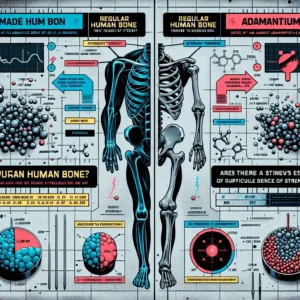Hello, movie enthusiasts!
Today, we’re diving deep into an important question about X-Men: “What strength did Wolverine’s Adamantium bones realistically have?”
The Direct Answer
Wolverine’s Adamantium bones, as depicted in the X-Men franchise, would be incredibly strong if they existed in reality, primarily due to the properties attributed to Adamantium in the series. However, in the real world, no material matches the fictional Adamantium’s combination of strength, indestructibility, and lightness. The closest real-world analogs, such as titanium alloys and carbon nanotubes, exhibit significant strength but fall short of the fantastical properties of Adamantium. Therefore, while Wolverine’s skeletal structure could theoretically possess immense durability, no current material science fully supports the existence of such a substance.
Now, let’s explore the extensive evidence and details that support this answer:
1. Understanding Adamantium: A Fictional Marvel
To appreciate the strength of Wolverine’s Adamantium bones, we must first understand the properties attributed to this fictional material.
A. The Origins and Properties of Adamantium
- Fictional Background: Adamantium was introduced in the Marvel Comics universe as an indestructible metal alloy. It is described as being nearly unbreakable once set, with a density and tensile strength that surpasses all known materials.
- Marvel’s Description: According to Marvel lore, Adamantium is a result of a secret government experiment, intended to create a super-soldier. It is known for its ability to withstand extreme forces without deformation, making it a perfect candidate for Wolverine’s skeleton.
- Comparison with Real Metals: In terms of fictional attributes, Adamantium combines the hardness of diamond with the toughness of steel, without the brittleness typically associated with such hardness.
B. Real-World Material Science
- Titanium Alloys: In the real world, titanium alloys are often cited as a close parallel due to their high strength-to-weight ratio. They are used in aerospace and medical implants, providing excellent durability and resistance to corrosion.
- Carbon Nanotubes: These are another material often compared to Adamantium due to their extraordinary tensile strength and light weight. They are 100 times stronger than steel and have been proposed for use in advanced structural applications.
- Limitations and Challenges: Despite their impressive properties, neither titanium alloys nor carbon nanotubes possess the indestructibility or the unique setting process of Adamantium. They are still susceptible to extreme conditions that Adamantium is said to withstand effortlessly.
C. Theoretical Implications
- Strength and Indestructibility: If Adamantium were real, it would need to exhibit a combination of properties that defy current material science, including absolute resistance to deformation and fracture.
- Biocompatibility: For Wolverine’s skeleton, the metal would need to be biocompatible, integrating seamlessly with human tissue without causing adverse reactions—a significant challenge for real-world materials.
In summary, while Adamantium’s properties are rooted in fiction, understanding its conceptual basis helps us appreciate the challenges in replicating such a material in reality.
2. The Physics Behind Indestructible Materials
The concept of indestructible materials like Adamantium challenges our understanding of physics and material science.
A. Theoretical Strength of Materials
- Tensile Strength: The maximum stress a material can withstand while being stretched or pulled before breaking. Materials like spider silk and carbon nanotubes exhibit high tensile strength.
- Hardness: A measure of a material’s resistance to deformation. Diamond is the hardest known natural material, yet it is brittle compared to the toughness required for Adamantium.
- Toughness: The ability to absorb energy and plastically deform without fracturing. Steel is known for its toughness, but it cannot match the fictional resilience of Adamantium.
B. Current Limitations in Material Science
- Ultimate Strength Limits: Research by scientists like Dr. Julia Greer from Caltech shows that even the strongest materials have limits. Her work on nanoscale materials pushes the boundaries of strength but still adheres to physical laws.
- Environmental Factors: Real-world materials degrade under environmental stressors such as heat, corrosion, and radiation. Adamantium’s supposed immunity to these factors remains purely speculative.
C. Technological Advances and Future Prospects
- Graphene and Boron Nitride: These materials are at the forefront of research due to their exceptional properties. Graphene, for instance, is incredibly strong and conductive, but it lacks the bulk properties needed for structural applications like bones.
- Advanced Alloys: Ongoing research in metallurgy aims to develop alloys with superior strength and durability. However, achieving the perfect balance of properties found in Adamantium remains elusive.
In conclusion, while current materials can achieve remarkable strength, the concept of an indestructible material like Adamantium defies the known laws of physics and material science.
3. Biological Considerations of Adamantium Integration
Integrating a metal like Adamantium into a biological organism presents unique challenges.
A. Biomechanics and Skeletal Support
- Load-Bearing Capacity: The human skeleton is designed to support the body’s weight and withstand physical stress. Replacing bones with metal must maintain or enhance this capability without compromising mobility.
- Joint Functionality: Metal bones would require precise articulation at joints to preserve movement. Real-world prosthetics use advanced engineering to mimic natural joint function, but full skeletal replacement is unprecedented.
B. Biological Compatibility and Integration
- Immune Response: The body’s immune system may reject foreign materials. In medical implants, biocompatibility is crucial to avoid inflammation or rejection.
- Osteointegration: Successful integration of metal with bone tissue is vital. Current techniques use porous coatings on implants to encourage bone growth, but achieving this with a full metal skeleton is speculative.
C. Longevity and Maintenance
- Wear and Tear: Over time, even the most durable materials can wear down. Adamantium’s fictional permanent durability contrasts with the reality of material fatigue and wear.
- Repair and Replacement: In the event of damage, repairing or replacing metal components in a biological system poses significant challenges, both technically and biologically.
In summary, the integration of a metal like Adamantium into a human skeleton involves complex biomechanical and biological considerations that far exceed current medical capabilities.
4. Additional Context and Considerations
To fully understand the implications of Adamantium, we must consider broader scientific and cultural contexts.
A. Cultural Impact of Indestructible Materials
- Symbolism in Media: Adamantium represents invincibility and resilience, themes that resonate with audiences. It symbolizes the ultimate defense against harm, a powerful narrative device in storytelling.
- Influence on Science Fiction: The concept of indestructible materials has inspired countless works of science fiction, pushing the boundaries of imagination and innovation.
B. Ethical and Practical Implications
- Military Applications: The idea of indestructible materials has military appeal, suggesting armor and weapons that could revolutionize defense. However, ethical considerations about weaponization and escalation arise.
- Medical Advancements: In medicine, materials that mimic Adamantium could lead to breakthroughs in prosthetics and implants, improving quality of life for many.
C. Scientific Exploration and Discovery
- Continued Research: Scientists continue to explore the limits of material science, seeking new composites and alloys that push the boundaries of strength and durability.
- Potential Breakthroughs: While Adamantium remains fictional, future discoveries in nanotechnology and materials science could bring us closer to achieving similar properties.
Conclusion: The Definitive Answer
Based on all the evidence we’ve examined:
- Fictional Foundation: Adamantium, as depicted in X-Men, is a fictional material with properties that defy current scientific understanding. Its strength and indestructibility are unmatched by real-world materials.
- Material Science Limitations: Current materials like titanium alloys and carbon nanotubes exhibit impressive strength but cannot replicate Adamantium’s unique properties.
- Biological Challenges: Integrating such a material into a human skeleton presents significant biomechanical and biological challenges, far beyond current medical science.
Final Verdict: While Wolverine’s Adamantium bones are a fascinating concept, they remain firmly within the realm of fiction. The strength attributed to Adamantium surpasses the capabilities of any known material, and the integration of such a metal into a living organism poses insurmountable challenges with today’s technology.
Reflecting on this analysis, Wolverine’s Adamantium skeleton serves as a powerful symbol of resilience and strength, capturing the imagination of audiences worldwide. While the material remains fictional, it inspires continued exploration in material science and biotechnology. As we push the boundaries of what is possible, the dream of creating materials with extraordinary properties may one day become a reality, bringing us closer to the fantastical world of X-Men.



